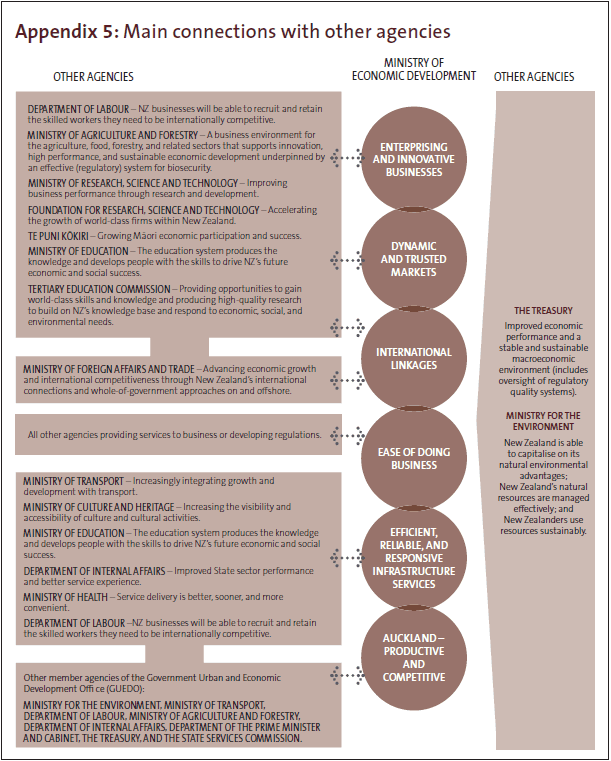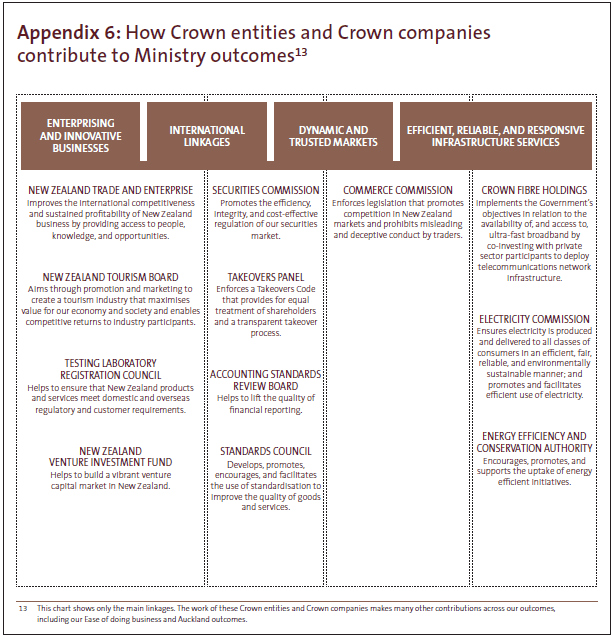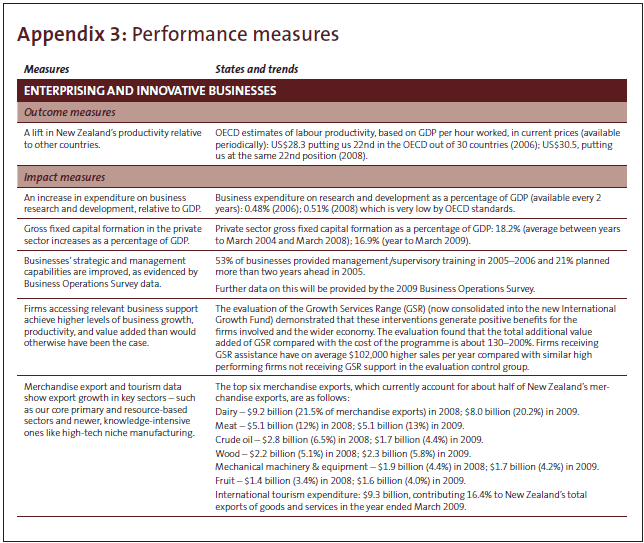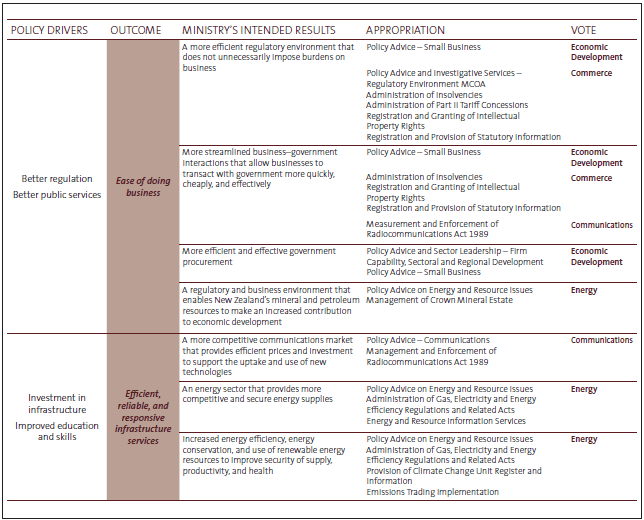Part 5: Ministry of Economic Development
Background
5.1
The Ministry provides advice to the Government on issues that affect the business environment as a whole and what the Government can do to develop the economy of New Zealand. The Ministry is also responsible for providing a range of services directly to businesses, including managing company registrations, managing the radio spectrum, and ensuring the safe supply and use of electricity and gas.
5.2
Its work supports Ministers in eight portfolio areas: Economic Development, Communications and Information Technology, Commerce, Energy and Resources, Tourism, Consumer Affairs, Small Business, and the Rugby World Cup. It also contributes to work for the Ministers for Infrastructure, Regulatory Reform, and Climate Change.
5.3
Overall, we consider that the Ministry's SOI demonstrates that a clear, coherent, and concise performance story can be presented even when a public entity has a complex and wide range of sector-wide responsibilities covering several Parliamentary Votes.
Strategic context
5.4
The Ministry's SOI provides a short summary of the challenging economic times that New Zealand and the rest of the world are currently facing. This provides useful context for the immediate priorities set by the Government, along with its long-term goal of "growing the economy to deliver greater prosperity, security and opportunities for all New Zealanders" (see Figure 9).
Figure 9
How the Ministry of Economic Development sets out its strategic context
| Key opportunities and challenges Although there is a risk of only a slow recovery in some major economies, the situation is looking much less gloomy than it was a year ago. In New Zealand, the economic situation remains patchy, and the recovery over the next year is likely to be modest. Looking further out, there should be significant opportunities for New Zealand to lift its long term economic performance and improve its prosperity – although vulnerability to further shocks remains. Exploitation of these opportunities will depend on creating the conditions for more balanced growth that supports the efforts of exporters and producers of tradeable goods and services – ensuring a more business-friendly environment and helping New Zealand businesses to raise their productivity. Against this background, the Government's goal is to lift the long-term performance of the economy, to make New Zealand a more prosperous country capable of providing well-paid jobs and a better standard of living, and to provide the world-class public services needed to give opportunity and security to New Zealanders. To achieve this goal, the Government has set out six main policy drivers that lie at the heart of its economic plan. These are:
|
Source: Ministry of Economic Development (2010), Statement of Intent 2010-2013, Wellington, page 7.
Specifying and presenting the outcomes framework
5.5
The Ministry clearly identifies its six long-term outcomes in the section "How we will work to support the Government's priorities". These outcomes (see Figure 10) are then used throughout the document to help the reader navigate through the performance story.
Figure 10
The Ministry of Economic Development's six long-term outcomes
| How we will support the Government's priorities We will contribute in particular to the first four of these drivers by delivering high-quality business services; supporting the development of business capability; assisting innovative and productive firms to thrive; helping to create a growth-friendly environment with low regulatory and business costs; and promoting investment in infrastructure. These contributions to the Government's policy drivers are captured in our six long-term outcomes: Enterprising and innovative businesses – improving the drivers for success and productivity improvement in firms. International linkages – improving the linkages that allow New Zealand firms to benefit from trade and the flows of investment, skills, and technology. Auckland – more productive and competitive for the region and New Zealand. Dynamic and trusted markets – improving the competitiveness, integrity, and effectiveness of New Zealand's markets. Ease of doing business – improving the way public agencies interact with, and the regulatory framework for, business. Efficient, reliable, and responsive infrastructure services – improving the quality and reliability of key infrastructure services that support growth. |
Source: Ministry of Economic Development (2010), Statement of Intent 2010-2013, Wellington, page 7-8.
5.6
The "Work Programme and Intended Results" section of the SOI takes the reader through each of the outcomes and results (impacts), and provides a clear picture of what the Ministry is planning to do, why, and how its activities will help achieve the desired result (impact). This is helped by the good use of subheadings and "pull quotes" (see Figure 11) to highlight main messages.
Figure 11
Example of a "pull-quote" used to highlight main messages

Source: Ministry of Economic Development (2010), Statement of Intent 2010-2013, Wellington, page 12.
5.7
The SOI also provides the reader with a clear sense of:
- how the Ministry works with other government departments; and
- the contribution made by the Crown entities for which the Ministry has an advisory and monitoring role. These contributions are clearly linked to the Ministry's outcomes and focus on what these entities do (see Figures 12 and 13).
Figure 12
The Ministry of Economic Development's relationship with other agencies

Source: Ministry of Economic Development (2010), Statement of Intent 2010-2013, Wellington, page 35.
Figure 13
How Crown entities contribute to the Ministry of Economic Development's outcomes

Source: Ministry of Economic Development (2010), Statement of Intent 2010-2013, Wellington, page 36.
Main measures and targets for outcomes and impacts
5.8
Early in its SOI, the Ministry set out how it would measure progress overall. It recognised the problems associated with measuring the contribution to outcomes made by its actions (see Figure 14).
Figure 14
How the Ministry of Economic Development would demonstrate success against its "Enterprising and innovative business" outcome
| How we will demonstrate success We will know there have been improvements in our international linkages if, over the long term, New Zealand's exports and outward investment grow as a percentage of GDP, along with New Zealand's share of world trade. We will know we are achieving our more specific results if:
|
Source: Ministry of Economic Development (2010), Statement of Intent 2010-2013, Wellington, page 12.
5.9
Within the "Work Programme and Intended Results" sections of the SOI, the Ministry includes a section for each outcome entitled "How we will demonstrate success" (see Figure 15). This clearly sets out the measures that it will use at both the outcome and the result (impact) level.
Figure 15
How the Ministry of Economic Development intends to demonstrate success
| How we will demonstrate success We will know that New Zealand businesses are becoming more enterprising and innovative if there is a lift in New Zealand's productivity relative to other countries. More specifically, we will know we are achieving our intended results if:
|
Source: Ministry of Economic Development (2010), Statement of Intent 2010-2013, Wellington, page 10.
5.10
The current status for each of these measures was set out in an appendix (see Figure 16).
Figure 16
How the Ministry of Economic Development set out the current status for each of its measures

Source: Ministry of Economic Development (2010), Statement of Intent 2010-2013, Wellington, page 30.
Linking outputs to impacts and outcomes
5.11
There are inherent difficulties in presenting the links between outputs and outcomes when the performance measures for outputs are included in the Information Supporting the Estimates rather than in the SOI.
5.12
The Ministry dealt with this by including a helpful diagram in its SOI (see Figure 17) that showed which departmental appropriations (output classes) contributed to achieving which outcomes. This information was consistent with the Information Supporting the Estimates.
Specifying outputs and output classes
5.13
The Ministry is responsible for 20 output classes funded through six Parliamentary Votes (see Figure 17). Given the complexity of the functions that the Ministry is responsible for, it is important to provide appropriate contextual information for the reader to understand how particular output classes contribute to particular impacts and outcomes.
Figure 17
Links between outcomes and departmental appropriations


Source: Ministry of Economic Development (2010), Statement of Intent 2010-2013, Wellington, page 28-29.
Performance measures and targets for outputs
5.14
The Ministry identified performance measures that broadly covered the diverse and complex activities that it was responsible for. One of the main outputs that the Ministry provides is policy advice, and it used a consistent set of performance measures for each of its six Parliamentary Votes.
Potential improvement
5.15
The Ministry could help the reader understand how its policy advice activity contributes to the Ministry's outcomes by including information about the key elements of:
- the policy work programme; and
- the evaluation and review programme and its results.
